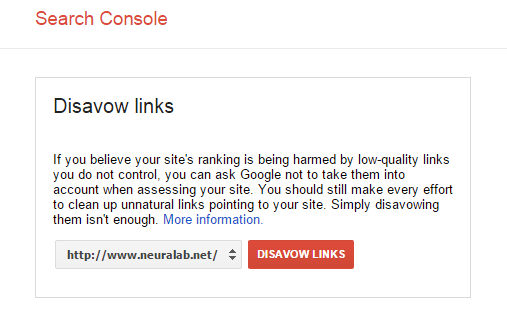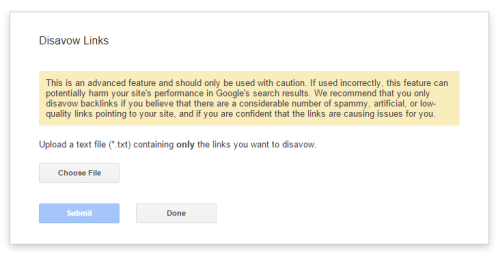How to Find, Identify and Remove Bad Backlinks From Your Website
Bad links are backlinks that point to your site from low quality, untrustworthy, irrelevant, spammy looking websites. Why should you remove them? Well, do you actually want some porn or gambling site link to you personal blog or company website?
There’s your answer. Accumulating lots of bad links will eventually hurt your SERP rankings. Google could also de-index some of your pages and that’s the reason you need to keep your linking profile as clean as possible.
After all, nobody wants to receive this kind of message from Google:
Dear site owner or webmaster of http://www.example.com/,
We’ve detected that some of your site’s pages may be using techniques that are outside Google’s Webmaster Guidelines. Specifically, look for possibly artificial or unnatural links pointing to your site that could be intended to manipulate PageRank. Examples of unnatural linking could include buying links to pass PageRank or participating in link schemes. We encourage you to make changes to your site so that it meets our quality guidelines. Once you’ve made these changes, please submit your site for reconsideration in Google’s search results. If you find unnatural links to your site that you are unable to control or remove, please provide the details in your reconsideration request. If you have any questions about how to resolve this issue, please see our Webmaster Help Forum for support.
Sincerely,
Google Search Quality Team
Ok. You don’t have to be paranoid about this, but if you analyze your link profile and see a big chunk of pesky backlinks pointing to your site, don’t wait for Google’s warning and continue reading…
Put all your backlinks in one list
One way of checking for bad links is to go to your web property in Webmasters Tools, go to search traffic and click on Links to Your Site. Here you will see some but not all the backlinks. Gathering backlinks through Google’s Webmasters Tool is just one way to do it but to make sure we pull up as much of the data we can, we also recommend using Open Site Explorer to make your list more complete.
Identifying bad links
After you’re done gathering backlinks into one list, identify the ones that might be hurting your website.
Now you’re thinking: Easier said than done. But how do I differentiate bad links from good ones?
And that’s a good question. There’s no quick and easy way to do this. Just use common sense and explore each and every link manually one by one. This is what you need to watch out for:
Porn, gambling, viagra types of links
You can probably recognize these even without clicking and analyzing the site.
Hidden links
Can’t find a backlink on the site? Try selecting everything on the page. White text on white background is an old trick which is still used.
Strange anchor text links
Someone has linked you with “best pills to get you slim fit” but your site is in totally different niche. You’re selling clown outfits. Therefore this link doesn’t make any sense.
Links from de-indexed websites
Check if site holding the link shows in Google search results (site:domainname.com). If it doesn’t return any result, you have every right to be suspicious about it.
Links from blog comments and forums
If they look spammy and their PR is 0 or n/a, you don’t need backlinks from these places.
Most important piece of advice when classifying backlinks is to use your own judgment. Ask yourself: How do I feel seeing this site linking to mine?
If you’re unsure on whether the link is bad or good, it’s best to leave it alone. Be careful. You don’t want to remove links that are actually helping your site rank well. When in doubt, just skip and move on to another one.
Removing bad links
Ok. Now it’s time to remove those bad links we discovered.
Most effective way is to contact site webmaster and ask him to remove a backlink. As that can be sometimes hard, especially if the site doesn’t have any info about its owner, your last resort is to listen to Matt Cutts, Google’s head of search spam who recommends using Google Disavow Tool.
This tool will not magically remove bad links from owners websites, it just won’t take certain links into consideration when assessing your website.
According to Google:
If you’ve done as much work as you can to remove spammy or low-quality links from the web, and are unable to make further progress on getting the links taken down, you can disavow the remaining links. In other words, you can ask Google not to take certain links into account when assessing your site.
Google Disavow Tool lets you upload a .txt file containing URLs and domain names you want to disavow. If you want to disavow backlinks on URL level that’s ok, but it’s certainly more effective to ignore all the links from an entire domain by adding a following line in the file “domain:example.com”. This way you’re made sure every bad link is disavowed without having to put multiple URLs in the file.
Here’s a sample of a valid file from Google support pages:

You have your file ready?
It’s time to upload it using a Google Disavow Tool.
1. Go to Google Disavow Tool and select your website

2. Click disavow links and choose a .txt file to upload

Click submit and that’s it.
It’s that easy.
Next time when Google crawl any of the sites from your file, hidden nofollow tags are going to be applied to the bad links, therefore making them worthless to Google when assessing your website.
High five! That’s how you combat bad links. Keep your site healthy by taking time to do this task more regularly.
If you have any feedback or suggestions, please feel free to contact us. We’d love to hear from you!







